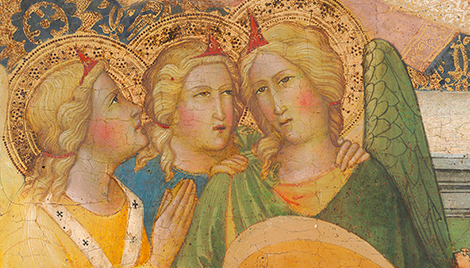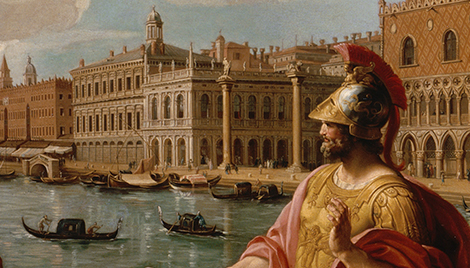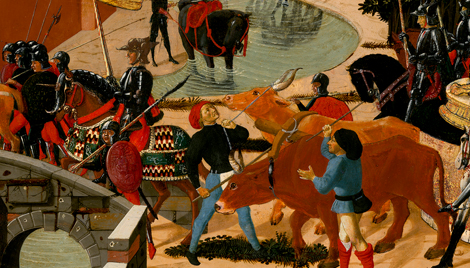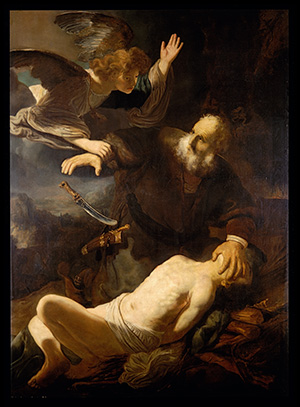Abraham's Sacrifice of Isaac
Abraham's Sacrifice of Isaac
- Artist
- Imitator of Rembrandt van Rijn
- Artist Dates
- 1606-1669
- Artist Nationality
- Dutch
- Title
- Abraham's Sacrifice of Isaac
- Date
- second half 17th century-18th century
- Medium
- oil on canvas
- Dimensions
- 183.6 x 132.8 cm (72-1/4 x 51-7/8 in)
- K Number
- K1633
- Repository
- Museum of Art and Archaeology
- Accession Number
- 61.83
- Notes
Provenance
Richard Paton; (his sale, Christie's London, 30 March 1792, no. 27). J.H. Cremer [d. 1886], Brussels. [1] Sir Frederick Lucas Cook [1844-1920], 2nd Bart, Doughty House, Surrey, England; by inheritance to Sir Herbert Frederick Cook [1868-1939], 3rd Bart. Doughty House; by inheritance to his son, Sir Francis Ferdinand Maurice Cook, 4th bt. [1907-1978], Doughty House. (Count Alessandro Contini Bonacossi [1878-1955], Rome-Florence); sold to the Samuel H. Kress Foundation on 10 March 1949 as Attributed to Rembrandt; gift to the Museum of Art and Archaeology, University of Missouri in 1961, n. 61.83. [1] This is possibly J. H. Cremer, whose collection was sold in two parts in Amsterdam, on 26 October 1886 and 21 June 1887. Although the painting is not included in either sale, part two consisted of a large number of paintings, mostly Dutch and Flemish, so it's possible Cremer owned this painting and had sold it at an earlier date.
Catalogue Entry
Imitator of Rembrandt van Rijn
Abraham's Sacrifice of Isaac
K1633
Columbia, Missouri, University of Missouri, Kress Study Collection, since 1961. Oil on canvas. 72 1/4 x 51 7/8 in. (183.6 x 132.8 cm.). Some modeling done by incision. Very small areas of in-painting in faces of Abraham and angel. An old horizontal fold or seam runs below Abraham's beard. Cleaned and restored by Modestini, 1961; well preserved. Abraham (Genesis 22:10-12), kneeling behind Isaac with his left hand over his son's face, is about to sacrifice the youth, who lies on a wooden pyre in the foreground; the patriarch is restrained by an angel, who flies from the upper left corner, grasping Abraham's right hand so that he drops his Near-Eastern jeweled dagger.(2) The figures are placed in a mountainous setting.(3) The Sacrifice of Isaac is the first religious subject listed by Karel van Mander in his influential poem of instruction to painters.(4) The Dutch edition of Ripa's Iconologia (Dirck Pietersz. Pers, Amsterdam, 1664) gave the subject of K1633 as an emblem of faith. Depictions of the subject may have been stimulated by Rubens's panel (Kansas City, Missouri, The Nelson Gallery and Atkins Museum) of c. 1614. A reproductive print was made by Andreas Stock in 1614.(5) Rembrandt's teacher Lastman painted the subject in 1616 (Paris, Louvre). The original of K1633 in The Hermitage could have been inspired by the Italianate works of Elsheimer.(6) Egbert Haverkamp-Begemann has noted the influence of Hercules Seghers (many of whose works were owned by Rembrandt) on the landscape view in the background.(7) The Kress canvas was described as an old copy after the one in The Hermitage by Bode and Hofstede de Groot.(8) K1633 was recorded in the Cook Collection as 'attributed to Rembrandt' after the Hermitage painting.(9) A second version of the same subject and dimensions with the angel approaching from behind Abraham is in the Munich Pinakothek. The painting is inscribed Rembrandt verandert en over geschildert 1636. This inscription has been interpreted to mean that the canvas is the work of a pupil (possibly Govaert Flinck), changed and improved by his teacher.(10) More recently Haak, noting the apparent homogeneity of the Munich painting, has suggested that the inscription may simply mean that Rembrandt changed the composition and painted the subject again (overgeschildert: 'painted anew'). A Rembrandt drawing in the British Museum in which the angel appears from behind offers a connecting link in the creative process.(11) Rembrandt etched the subject in 1655, and included it in a tiny roundel in the top right corner of his Elderly Man as St. Paul in London (National Gallery).(12) Several of his students or followers, including Bol, Flinck and Gherwen, depicted the subject reflecting both the Leningrad and Munich compositions. An inferior copy after the Hermitage canvas was in the collection of Felix Ravaisson, 87 x 70 cm. (Sold in Paris, 23 Nov. 1903, Cat. No. 87). K1633 need not be the work of a Dutch painter –Rembrandt was much copied in the eighteenth century in Germany and elsewhere. The almost rococo treatment of detail and chiaroscuro would indicate that the Kress canvas was painted by an artist of the late seventeenth or eighteenth century. Provenance: Possibly Richard Paton (sale, London, Christie's, 30 Mar. 1792, p. 4, Cat. No. 27).(13) Cremer, Brussels.(14) Sir Frederick Cook, Doughty House, Richmond, Surrey. Sir Herbert Cook. Florence, A. Contini-Bonacossi. Kress acquisition 1949.
References
(1) K1633 was reproduced in the Feest-bundel Dr. Abraham Bredius, Amsterdam, 1915, by Cornelis Hofstede de Groot ('Rembrandts onderwijs aan zijne leerlingen', pp. 79-94, pl. 20, fig. 7), who mislabeled it as the painting in The Hermitage. (2) See Hans Bonnet, Die Waffen der Völker des alten Orients, Leipzig, 1926, p. 85. For such weapons in Rembrandt's collection see Hofstede de Groot, Die Urkunden über Rembrandt, The Hague, 1906, pp. 207-8. (3) For the iconography of the Sacrifice of Isaac see Réau, II, I, pp. 134-7; also Ralph T. Coe, 'Rubens in 1614: the Sacrifice of Abraham', The Nelson Gallery and Atkins Museum Bulletin, IV, 1966, pp. 1-24, esp. pp. 1-6. (4) See the edition by R. Hoecker, Das Lehrgedicht des Karel van Mander, The Hague, 1916, p. 123 (Chapter V, verse 65). (5) See Coe, op. cit., p. 8, fig. 6. (6) For links between the second version of Rembrandt's Sacrifice of Isaac and the art of Lastman see Wolfgang Stechow, 'Some Observations on Rembrandt and Lastman', Oud-Holland, LXXXIV, 1969, pp. 148-62. (7) Lecture at Institute of Fine Arts, New York University, Spring 1971. (8) Wilhelm Bode and C. Hofstede de Groot, Rembrandt, Paris, 1899, III, p. 162. (9) Maurice W. Brockwell, Catalogue of the Paintings at Doughty House, London, 1915, II, p. 80, no. 323; also the Abridged Catalogue ... , London, 1932, p. 84, no. 323. (10) Kurt Bauch, Rembrandt Gemälde, Berlin, 1966, p. 29, Cat. No. A1O. (11) Bob Haak, Rembrandt: His Life, His Work, His Time, New York, 1969, pp. 192-3, trans. from the Dutch by Elizabeth Willems-Treeman. (12) Neil MacLaren, The Dutch School, The National Gallery Catalogues, London, 1960, pp. 319-20, Cat. No. 243. (13) The Paton canvas may possibly be the one owned by Felix Ravaisson, sold in Paris (Mollien), 23 Nov. 1903, Cat. No. 87. (14) Possibly identical with J. H. Cremer, whose collection was sold in Amsterdam (Pictura), 26 Oct. 1886. The painting is not listed in the first part of the sale.






